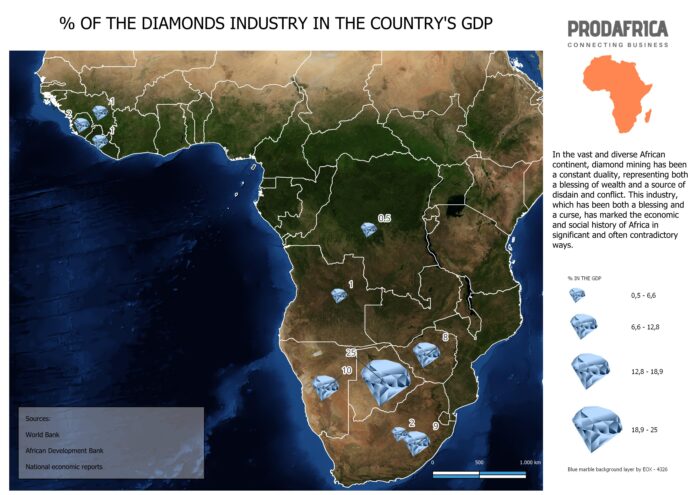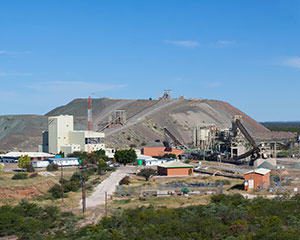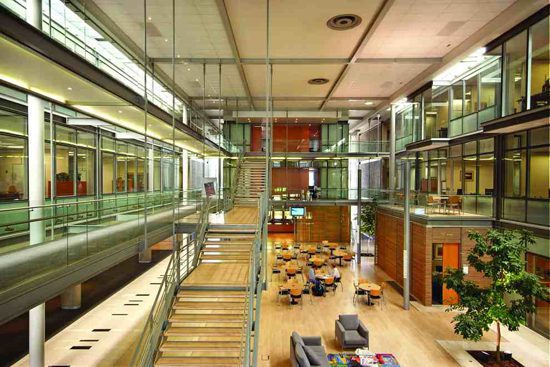Diamond Mining in Africa. In the vast and diverse African continent, diamond mining has been a constant duality, representing both a blessing of wealth and a source of disdain and conflict. This industry, which has been both a blessing and a curse, has marked the economic and social history of Africa in significant and often contradictory ways.
A Gift of Wealth and Development
Economic Prosperity
In countries like Botswana, where the diamond industry contributes an estimated 25% to the national GDP (19.3 billion USD), diamond mining has been a true blessing, transforming an impoverished nation into a flourishing economy with developed infrastructures and economic stability. Diamonds have been a significant source of revenue, generating wealth and employment opportunities in several African nations.
Infrastructure Development
The industry has been a primary source of financing for the development of critical infrastructures, including roads, schools, and hospitals. This has facilitated better quality of life and education in various regions, promoting sustainable development and uplifting entire communities. In South Africa, for instance, with a GDP of 317.6 billion USD, the diamond industry, although contributing a lesser 2% to the GDP, has been instrumental in the country’s infrastructural development.
Innovation and Technology
Furthermore, diamond mining has fostered innovation and technology transfer in the region. The need for advanced technologies in diamond extraction and processing has promoted the adoption of modern technologies, thus driving technological progress and fostering research and development in related sectors.

A Curse of Inequality and Conflict
Socioeconomic Inequalities
However, the wealth generated by diamonds has not always been distributed equitably. In many cases, it has exacerbated socioeconomic inequalities, with a small elite enjoying the majority of the riches while the general population remains in poverty. This phenomenon is evident in countries like Angola, where despite a significant GDP of 89.6 billion USD, the diamond industry only contributes 1% to the GDP, indicating an unequal distribution of the wealth generated by this industry.
Conflicts and Blood Diamonds
Diamond mining has also been a source of conflicts, especially in countries like Sierra Leone and the Democratic Republic of the Congo. “Blood diamonds”, or diamonds mined in war zones and sold to finance armed conflicts, have brought devastation to these regions, fueling cycles of violence and exploitation. These conflicts have had significant economic repercussions, destabilizing entire regions and hindering sustainable economic development.
Environmental Impact
Diamond extraction has also had a significant impact on the environment, with landscape degradation, habitat destruction, and water pollution being common issues associated with diamond mining. These environmental impacts have significant economic costs, including the loss of biodiversity and the costs associated with environmental remediation.
Industry Giants: De Beers and Beyond
At the epicenter of the diamond industry in Africa is De Beers, a multinational corporation that has dominated the diamond trade since the 20th century. Founded in 1888 in South Africa, De Beers has had a significant influence in shaping the diamond industry, controlling at one point up to 90% of the global diamond market. With mines in countries like Botswana, Namibia, and South Africa, the company has been a key player in the economic development of these regions.
However, De Beers’ domination has been challenged in recent decades by other large companies and diamond producers, including ALROSA in Russia and Lucara Diamond Corp in Botswana. These companies have introduced greater competition in the industry, fostering innovation and the adoption of more sustainable and ethical technologies in diamond mining.
Additionally, these companies have begun to focus on more sustainable and ethical practices, working to reduce the environmental impact of diamond mining and promote a more equitable distribution of economic benefits. Through corporate responsibility initiatives, these companies are seeking to redefine the narrative of diamond mining in Africa, transforming it from an industry marked by exploitation and conflict to one that promotes sustainable development and economic prosperity.
Towards a Sustainable Future
Sustainability Initiatives
Despite the challenges, there are concerted efforts to ensure that diamond mining benefits local communities and does not fuel conflicts. Initiatives like the Kimberley Process seek to curb the flow of blood diamonds, promoting ethical and sustainable mining practices. These initiatives also seek to foster transparency and accountability in the industry, thus promoting a more equitable distribution of economic benefits.
Beneficiation and Added Value
Several countries are looking to add value to their diamond resources through beneficiation, which includes locally cutting and polishing diamonds. This creates more employment opportunities and retains more value within the country, promoting sustainable economic development. In Lesotho, for example, where the diamond industry contributes a significant 9% to the GDP (2.58 billion USD), there is a growing focus on adding value through local beneficiation.
Education and Training
Additionally, there is a growing focus on education and training, with programs designed to equip local communities with the necessary skills to participate in and benefit from the diamond industry. These programs seek to foster the development of local skills, thus promoting broader participation in the industry and fostering inclusive economic growth.
Then
Diamond mining in Africa is a story of contrasts, one that has brought both wealth and disdain. As the continent seeks a more sustainable future, it is imperative that ethical and sustainable mining practices are promoted, ensuring that diamonds are truly a blessing and not a curse for Africa.
On this path to sustainability, Africa has the opportunity to rewrite its narrative, transforming diamond mining from a curse to a lasting gift for its peoples.
Table: Total GDP and Contribution of the Diamond Industry to GDP in African Diamond Producing Countries (2022 estimate)
| Country | ISO 3166-2 Code | Total GDP (in billion USD) | Contribution of the Diamond Industry to GDP (%) |
|---|---|---|---|
| Botswana | BW | 19.3 | 25% |
| South Africa | ZA | 317.6 | 2% |
| Namibia | NA | 14.5 | 10% |
| Angola | AO | 89.6 | 1% |
| Zimbabwe | ZW | 24.3 | 8% |
| Democratic Republic of the Congo | CD | 47.2 | 0.5% |
| Guinea | GN | 13.9 | 1% |
| Lesotho | LS | 2.58 | 9% |
| Liberia | LR | 3.29 | 1% |
| Sierra Leone | SL | 4.10 | 2% |
Sources:
- World Bank
- African Development Bank
- National economic reports

Team ProdAfrica
team@prodafrica.com




